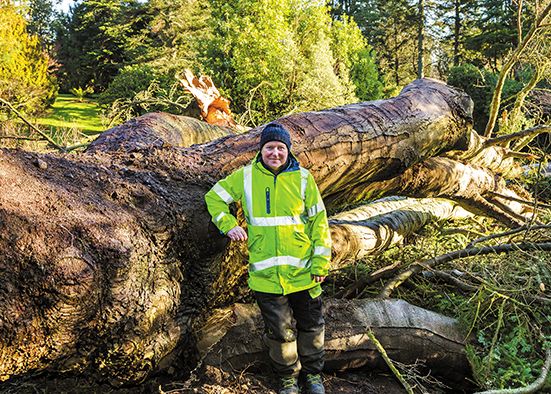‘Heartbreak’ as 1,000 rare trees destroyed as staff begin clean-up amid plans for future
‘Heartbreak’ as 1,000 rare trees destroyed as staff begin clean-up amid plans for future
12 February 2025

AS the ravages of Storm Éowyn continue to reverberate across the district, the green shoots of recovery are already taking shape at Castlewellan Forest Park which bore the full brunt of the hurricane force winds.
Over 1,000 trees were felled across the sprawling park with the result that a number of scenic walks are expected to remain closed for some time.
The storm also literally obliterated sections of the hugely popular mountain bike trails, which were left unrecognisable, with award-winning and internationally recognised trees planted over a century and a half ago brought crashing to the ground as the devastatingly destructive storm mercilessly bludgeoned its way through parkland.
The historic walled garden bore the brunt of the storm with up to 50 trees in this area alone snapped like twigs, with internationally recognised and revered trees literally ripped from the ground.
Almost three weeks on from the storm, staff have started to recover from the heartbreaking scenes which greeted when they entered the park.
When they arrived the morning after one of the worst storms in living memory, staff looked on in stunned silence, trying to take in the apocalyptic scenes before them. But there was no time for sentimentality.
Parking the shock of scenes that will never leave them, staff set about a mammoth clean-up operation which will take many more weeks, if not months to complete.
Attention also turned to planning for the future with the operation spearheaded by head gardener Alwyn Sinnamon and his dedicated team.
Alwyn lives and breathes the forest park and as a hard winter frost slowly started to lift last Thursday morning in crisp sunshine when he spoke to the
Recorder, the head gardener arrived with a sapling which had been propagated from the biggest tree in the walled garden — an Algerian Fir — which was no match for the power of Mother Nature as it was unceremoniously felled.
“The big tree took some beating in the storm and you can trace its path right through the park,” he said.
“It came through the shelter belt and took lots of trees with it, going right up the walled garden, breaking limbs off trees. The storm made its way into the spring garden and blew a load of trees down there and went straight into the rhododendron wood and also did damage in there. There were just massive gusts of wind.”
Alwyn had been sent a few images of the storm damage the morning after it cut its destructive path through the stunning forest park.
“I had been warned what to expect but the damage was much worse than I imagined,” he recalled.
“One of the largest trees close to the fountain in the walled garden was down but, thankfully, it missed the historic fountain by inches. When I saw that
I knew we were looking at major damage,” he continued.
“I couldn’t believe the damage in the bottom corner of the walled garden. When I heard the shelter belt had failed I knew things were going to be really bad. The belt was designed to protect the trees behind it including Scots pine, leylandii, Norway maple and sycamore.”
Alwyn, who has worked at the forest park for 14 years, said its stunning collection of trees comes from all over the world, with many of them regarded in the wild as endangered.
“We have some pretty rare stuff in here,” he said, standing in the shadow of behemoth trees in the walled garden.
“What was really heartbreaking for us was the loss of some of the collection of New Zealand plants and they were all coming up on 100 years old and were all British and Irish champions. The rare New Zealand black and white pines was the rarest plant in the garden.”
While storms are nothing new, more ferocious winds are forecast for the future with many convinced it’s due to climate change. “I have never seen such significant damage at the forest park,” revealed Alwyn.
“You always get big storms and in 2017 Storm Ophelia blew down the oldest tree in the walled garden where we have lost about 20 trees alone this time. Lots of others on the side of Slievenaslat mountain were blown down and there was a lot of damage. I have never before witnessed anything on this scale. This was a different animal.”
With the shock of what happened still bubbling below the surface, Alwyn said you can’t but help get attached to the trees.
“You give tours and talk about them so much and you know everything about them,” he said. “When you survey the damage you are in shock for a day or two, but once you get your head cleared a bit, you begin to plan ahead.
“Although some mornings when you wake you ask yourself did this really happen, but when you drive in it hits you. This was real.”
Alwyn said staff were shocked for a day or two but knew they had to dust themselves down and start clearing blocked paths, to assess the scale of the damage, critically examine what has been lost and what can be saved.
“We are still coming across damage and high winds a week after Storm Éowyn brought down another tree that had been weakened. We try our best to check every tree and a huge one blew down at the back of the castle. The worry is that we could lose more trees in the next big storm.”
Alwyn said he feels the loss of every tree with the felling of the Algerian Fir in the walled garden marking the end of an era. He said the tree was one of only 200 of its kind in the world, with the species close to extinction.
But six saplings have been propagated from it and while it will be several more years before they are planted, the Algerian Fir’s legacy will continue at the forest park.
“I think we are leaving a legacy like all those who have gone before us,” said Alwyn.
“Gardeners are pretty sensitive, forward thinking hearty people. You are working with the seasons and outside most of the time and you really are at one with nature. We will never see the trees we are planting now in all their glory but it was the same for people like Thomas Ryan, a former head gardener appointed by the Fifth Earl of Annesley.
“We are thinking 40, 50 and 100 years ahead and are surrounded by magnificent trees because of the work of others many generations ago.”
Alwyn continued: “We recently planted a tree shelter belt but it will be 60 years before it has fully matured. Hopefully the gardeners in charge then will thank us for our efforts as we have thanked those before us.
“Castlewellan Forest Park is unique in global terms and in its heyday was the top garden to come and see conifers of the world. In 2018, members of the International Dendrology Society came here on a visit.
“When they arrived, they could not believe what they were seeing and literally ran from tree to tree in the walled garden like children in a sweetie shop. They could not believe what we had in Castlewellan. It really is a pretty special tree collection.”
As Alwyn and his team plan for the future they are determined to continue with their good work and make one of the best in the world even better.
Reflecting on Storm Éowyn, Alwyn said while he hopes its the last of its kind and whether or not you believe in climate change, when you work in the forest park you can see that storms are becoming more violent.
“That’s what we find. We could get more of these storms and that changes the way we think and what we are going to plant as we have noticed that its similar trees across the country which are being blown over with Eucalyptus seemingly the one most affected,” he said.
As the planning continues, Alwyn remains as enthusiastic as ever.
He added: “When you come here, something special happens to you and you fall in love with the place. You don’t want to leave.”


